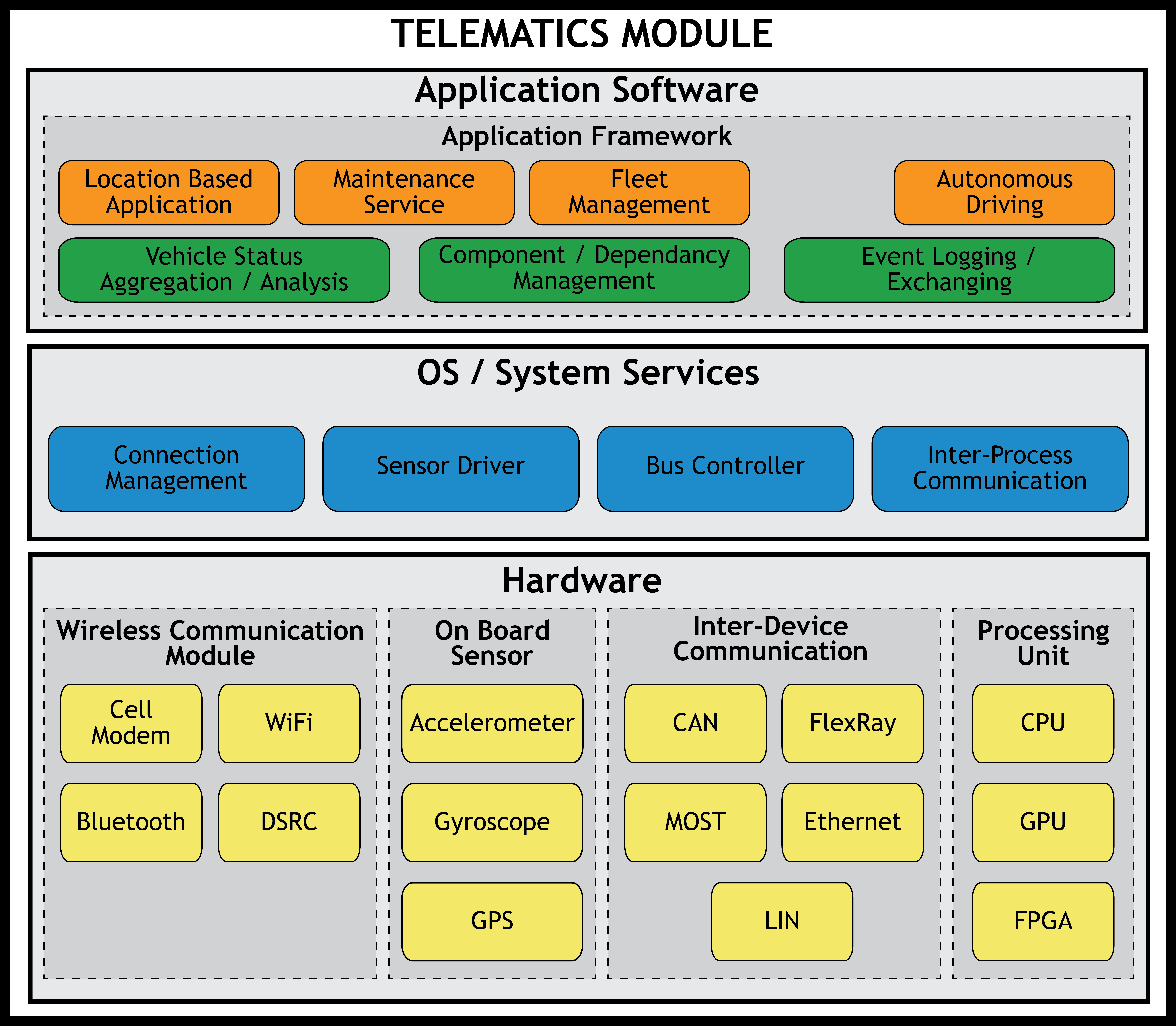Modern vehicles are equipped with various sensors which can monitor the status of the vehicle and the driver. The telematics data generated from those sensors not only improve the driving safety, but also create the possibility of many innovative services.
Telematic Control Unit (TCU) is an embedded device on a vehicle that collects the information of the vehicle and sends it to a remote system for analysis. A typical TCU may consist of a processing unit, a localization device (e.g. global positioning system, GPS), and a communication device (e.g. cell modem). The main purpose of having a onboard is to collect the vehicle status remotely, so that the services can be provided anytime and anywhere.
TCU Architecture
To accomplish the features required by the aforementioned use cases, the TCU systems are integrated with various hardware and software components. Depending on the services a
TCU provides, the architecture can be simple or complex. The functionality of the components can be categorized into to three categories:
Sensing: The essential feature of the TCU is obtaining the vehicle status. On board sensors
such as accelerometers, gyroscopes, or GPS provide the basic information such as acceleration, velocity, bearing and the location. If more information is required, the TCU needs to use Inter-Device communication (e.g. CAN bus) to interrogate other sensing devices in the vehicle.
Computation: The raw data generated by the sensor devices can be huge, especially the data produced by the image sensors. In order to reduce the traffic for transmitting the data as well as the latency between the devices and the back-end services, pre-processing of the data is desired. In addition to the general processors, GPUs or FGPAs are commonly used for better efficiency and performance.
Communication: To convey the telematics data or even provide the gateway functionality
to other in-vehicle devices, various communication facilities are integrated. While cellular
modems (e.g. LTE and 5G) are becoming the de facto components for the TCU, other communication technologies such as WiFi, Bluetooth, and DSRC are used in the situations where the bandwidth, locality, or inter-connectivity should be taken into account.

aicas Telematics Solution
Jamaica Frameworks provides modular components which can be easily reconfigured and delivered on demand. JamaicaCAR is an end-to-end automotive software platform, it integrates the edge computing and cloud services to support data processing for the embedded devices. This provides a foundation to the features which can be developed amount the ecosystem of the telematics market. On top of that, several directions can be pointed out to enrich the product itself and fulfill the demands from various parties.
JamaicaCAR is the end-to-end automotive software platform connecting devices via a defined interface that supports business typical connections with a middleware functionality hat is able to filter, map and convert the data going through this backplane to a cloud interface towards cloud service providers, like AWS, Azure, etc.. Configuration of this edge system is done with a graphical interface as well as via the backplane capabilities and via an API. The system is able to manage the data locally (e.g. present data to an HMI) and forward this via the Cloud API.
JamaicaCAR will be responsible to:
JamaicaEDG is a software platform established on top of a HW/OS platform: Middleware.
JamaicaEDG allows human users to gain information about one or more connected (computing) systems. Also, makes be possible to configure, access, organization, modification, consumption and visualization, hence control of data flows.
JamaicaEDG allows device data management (Visualizing JamaicaCAR assembled data, interaction by parametrizing the system, move data)
JamaicaEDP, or Jamaica Embedded Device Portal, is a complex software platform, intended to provide end to end IoT integration of end customer device fleets running on Jamaica frameworks.
JamaicaEDP is the aicas product that run on the cloud, being available to the end user as a web application in a browser, while the client part is provided by a special bundle installed on top of the Jamaica framework running in the devices.
JamaicaEDP allows functional device management (Tuning device logic, updates, moving logic), DevOps
Reference Design Storyboard
This story board walks the evaluator through the expected experience when operating the reference design. It also acts as a story for delivering the demonstration to evaluators for live or recorded events.
Device Commissioning and Provisioning
How the device will be up and running with local network, JamaicaCAR starts operating gathering data from vehicle and provisioning to the cloud;
Device throughput for local operation
Although the local device during normal operation would be headless, JamaicaCAR can provide vehicle data to a local ui application that demonstrates to the user the throughput for incoming data, how the TCU operates on that data going to the cloud.
Cloud operator experience
After the local TCU shows to be operating properly, cloud dashboard will show in a web console that in near real time displays statistics about the data coming from the TCU. The UI should be a dashboard-like experience.
Configuring tune-able parameters
From the web console will be possible to tune the property on the TCU running JamaicaCAR. e.g. Change the data acquisition rate from 10 seconds to 5 seconds
Operating without connectivity (recorder)
Based on the requirement, the TCU can switch to a different aggregation mode by changing the data pipeline of the micro services on the JamaicaCAR. For instance, a more aggressive data compression or a feature extraction module can be used when the connectivity is not available. The normal operation mode can be resumed when the connectivity is available again.
Hardware Components
Software Components
Qt, HTML5, JavaFX (local visualization)
- TCU provides vehicle data locally available to other in-vehicle devices (e.g. IVI). The local visualization can be presented on the devices with UI.
JamaicaCAR (local operation)
?AWS, Azure… (for cloud operation and visualization)
JamaicaEDG (device data management)
JamaicaEDP (functional device management)
Attachments
